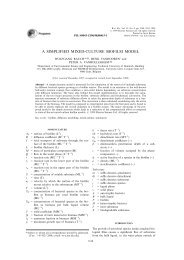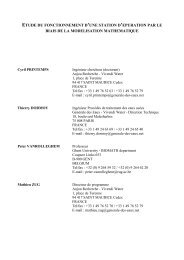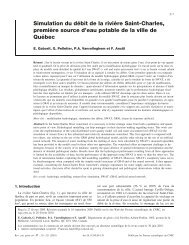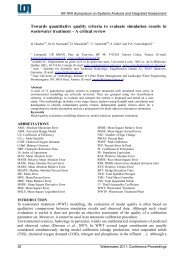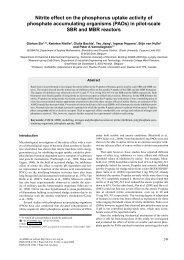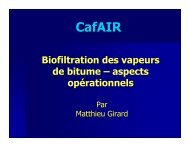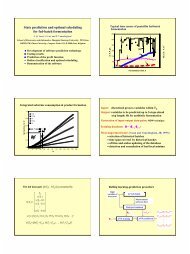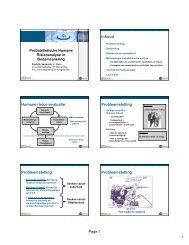Modeling 17α-ethinylestradiol removal in membrane bioreactors
Modeling 17α-ethinylestradiol removal in membrane bioreactors
Modeling 17α-ethinylestradiol removal in membrane bioreactors
You also want an ePaper? Increase the reach of your titles
YUMPU automatically turns print PDFs into web optimized ePapers that Google loves.
Poster Session<br />
WWTmod2012<br />
the most potent endocr<strong>in</strong>e disrupters and its environmental concentration is known to impact<br />
endocr<strong>in</strong>e system and reproductive functions of aquatic organisms, amphibians, birds and<br />
mammals. EE2 was shown to be primarily removed by sorption <strong>in</strong> CAS system (Andersen et al.,<br />
2005) because this synthetic hormone has a low biodegradability and a high hydrophobicity. EE2<br />
biodegradation has been ma<strong>in</strong>ly attributed to co-metabolism through the key enzyme of<br />
nitrification, the ammonium monooxygenase (AMO) (Yi and Harper, 2007). The long SRT applied<br />
<strong>in</strong> the MBR process supports the development of nitrify<strong>in</strong>g biomass and thus, is expected to<br />
improve EE2 <strong>removal</strong>.<br />
The first step of the study was to collect an extensive experimental data set on EE2 <strong>removal</strong> <strong>in</strong> a<br />
pilot-scale MBR operated under various conditions. Then, the experimental data were used to<br />
develop and calibrate the MBR model. The f<strong>in</strong>al objective was to apply the academic knowledge<br />
acquired for EE2 to the optimization of wastewater treatment plant (WWTP) design and operation.<br />
METHODS<br />
<strong>17α</strong>-<strong>eth<strong>in</strong>ylestradiol</strong><br />
The values of the partition coefficient of EE2, K D , <strong>in</strong> the literature range from 0.28 l/g (Gomes et<br />
al., 2011) to 1.0 l/g (Clara et al., 2004). Its octanol-water partition coefficient, K OW , varies between<br />
4677 l/g and 14125 l/g while its Henry’s law constant is 7.94 * 10 -12 atm.m³/mol (de Mes et al.,<br />
2005). Therefore, EE2 is assumed to be non-volatile and susceptible to sorption. Moreover, studies<br />
have shown that EE2 is slowly biodegradable under aerobic conditions when nitrify<strong>in</strong>g bacteria are<br />
present (Shi et al., 2004).<br />
Experimental data<br />
Activated sludge sampled from a full-scale CAS system was grown on a synthetic substrate (C/N/P:<br />
100/10/2) dur<strong>in</strong>g 83 days <strong>in</strong> a <strong>membrane</strong> bioreactor (MBR) consist<strong>in</strong>g of a reactor followed by an<br />
external <strong>membrane</strong> (Clouzot et al., 2010). Afterwards, EE2 was added <strong>in</strong> the <strong>in</strong>fluent at a constant<br />
concentration of 0.5 mg.L -1 dur<strong>in</strong>g 16 days. The hormone was quantified <strong>in</strong> the permeate to<br />
calculate its <strong>removal</strong>.<br />
The MBR was operated under different conditions to evaluate the effect on EE2 <strong>removal</strong> (Table 1).<br />
A hydraulic retention time (HRT) of 20h was first tested and then, a 7h-HRT was applied to<br />
simulate an overload of pollution. EE2 was removed from the <strong>in</strong>fluent between the two HRTexperiments.<br />
Dissolved oxygen was provided on a cyclic period to allow two hours of aerobic<br />
conditions followed by one hour of anoxic conditions.<br />
Table 1. Operat<strong>in</strong>g conditions of the different experimental phases<br />
Phase 1<br />
(2.4 days)<br />
Phase 2<br />
(4 days)<br />
Phase 3<br />
(8 days)<br />
HRT 20 h 20 h 7 h<br />
EE2 YES NO YES<br />
Substrate YES YES YES<br />
Oxygen YES YES YES<br />
166



